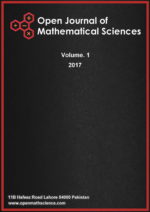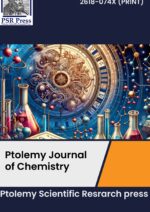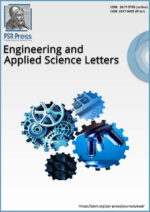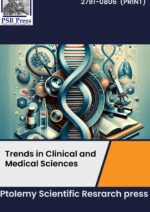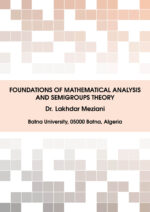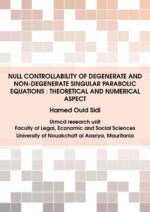Ptolemy Scientific Research Press (PSR Press)is a highly regarded publisher of scientific literature dedicated to bringing the latest research and findings to a broader audience. With a focus on cutting-edge research and technology, Ptolemy Scientific Research Press offers a range of publications catering to professionals, researchers, and student’s needs. Whether looking for information on the latest breakthroughs in physics, biology, engineering, or computer science, you can trust Ptolemy Scientific Research Press to deliver insightful, accurate, and engaging content. With its commitment to quality, accessibility, and innovation, Ptolemy Scientific Research Press is an essential resource for anyone interested in science and technology.

Latest Published Articles
OMA-Vol. 3 (2019), Issue 2, pp. 81 – 90 Open Access Full-Text PDF
Djelloul Ziane, Rachid Belgacem, Ahmed Bokhari
Abstract: In literature, there are many methods for solving nonlinear partial differential equations. In this paper, we develop a new method by combining Adomian decomposition method and Shehu transform method for solving nonlinear partial differential equations. This method can be named as Shehu transform decomposition method (STDM). Some examples are solved to show that the STDM is easy to apply.
Analytical solution of isotropic rectangular plates resting on Winkler and Pasternak foundations using Laplace transform and variation of iteration method
EASL-Vol. 2 (2019), Issue 4, pp. 6 – 20 Open Access Full-Text PDF
M. G. Sobamowo, O. M. Sadiq, S. A. Salawu
Abstract: Dynamic analysis of isotropic thin rectangular plate resting on two-parameter elastic foundations is investigated. The governing system is converted to system of nonlinear ordinary differential equation using Galerkin method of separation. The Ordinary differential equation is analyzed using hybrid method of Laplace transform and Variation of iteration Method. The accuracies of the analytical solutions obtained are verified with existing literature and confirmed in good agreement. Thereafter, the analytical solutions are used for parametric studies. From the results, it is observed that, increase in elastic foundation parameters increases the natural frequency. Increase in aspect ratios increases the natural frequency. It is expected that the present study will add value to the existing knowledge in the field of vibration.
A comparative analysis of the travelling salesman problem: Exact and machine learning techniques
ODAM-Vol. 2 (2019), Issue 3, pp. 23 – 37 Open Access Full-Text PDF
Jeremiah Ishaya, Abdullahi Ibrahim, Nassirou Lo
Abstract: Given a set of locations or cities and the cost of travel between each location, the task is to find the optimal tour that will visit each locations exactly once and return to the starting location. We solved a routing problem with focus on Traveling Salesman Problem using two algorithms. The task of choosing the algorithm that gives optimal result is difficult to accomplish in practice. However, most of the traditional methods are computationally bulky and with the rise of machine learning algorithms, which gives a near optimal solution. This paper studied two methods: branch-and-cut and machine learning methods. In the machine learning method, we used neural networks and reinforcement learning with 2-opt to train a recurrent network that predict a distribution of different location permutations using the negative tour-length as the reward signal and policy gradient to optimize the parameters of recurrent network. The improved machine learning with 2-opt give near-optimal results on 2D Euclidean with upto 200 nodes.
Software quality assurance of cryocooler drive electronics software used in spacecraft
EASL-Vol. 2 (2019), Issue 4, pp. 1 – 5 Open Access Full-Text PDF
Savitha A, Sudeesh B, PrakashaRao P J V K S
Abstract: Software plays an important role in the ISRO space mission. Reliability of this software is vital to achieve zero defects in space systems and services. There are varieties of software used in realization of spacecraft. Mainly it is categorized into onboard, mission and ground software. Evaluation of this software is the major activity for a software quality assurance person. Software quality engineer has to certify the software based on system level requirements, mission requirements and functional requirements. All the hardware and software interactions also have to be verified. Risk management is the key factor for effective software management. Software life cycle activities are carried out based on ISRO software process document. Following these standards and guidelines helps to find the defects in the earlier phase of software development life cycle. This paper mainly describes the software quality assurance activities carried out for control drive electronics unit used in GSAT spacecraft. SQA activities complied against the IEEE12207 standards (ISPD-2) at ISRO level. Pulse Tube Cryocoolers are active cryogenic devices used to generate cryogenic temperatures in the 50K-80K range in a single stage. Cryocooler drive electronics unit generates identical drive to both the compressors of pulse tube cryocooler.
Wiener index of uniform hypergraphs induced by trees
ODAM-Vol. 2 (2019), Issue 3, pp. 19 – 22 Open Access Full-Text PDF
Andrey Alekseevich Dobrynin
Abstract: The Wiener index \(W(G)\) of a graph \(G\) is defined as the sum of distances between its vertices. A tree \(T\) generates \(r\)-uniform hypergraph \(H_{r,k}(T)\) by the following way: hyperedges of cardinality \(r\) correspond to edges of the tree and adjacent hyperedges have \(k\) vertices in common. A relation between quantities \(W(T)\) and \(W(H_{r,k}(T))\) is established.
ASpin-NMR data reporting tool
OJC-Vol. 2 (2019), Issue 2, pp. 9 – 14 Open Access Full-Text PDF
Francesco Sinopoli, Alessandro Sinopoli
Abstract: Nuclear Magnetic Resonance spectroscopy, commonly referred as NMR spectroscopy, is a widely used technique for determining the structure of organic compounds and metallorganic complexes. The NMR characterization process can be done automatically by specific tools integrated into the main NMR dedicated software, however it is commonly subjected to user’s interpretation therefore it still remains a manual process. In relationship with the number of signals to interpret and the complexity of the spectrum, the user usually spends between ten minutes and one hour to manually generate an NMR report, which can be clearly affected by typos or format mismatches. Here we report an Excel sheet-based NMR data reporting tool which, thanks to ad hoc macros, generates as output a formatted NMR report, ready to be directly pasted into any manuscript. ASpin tool leaves to the users the full possibility to interpret the spectrum in this way they can gain more experience in the interpretation process, without giving up the time saving.

